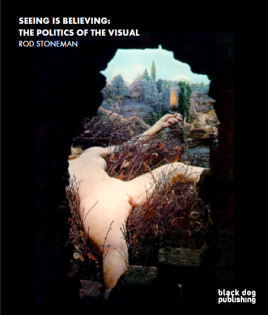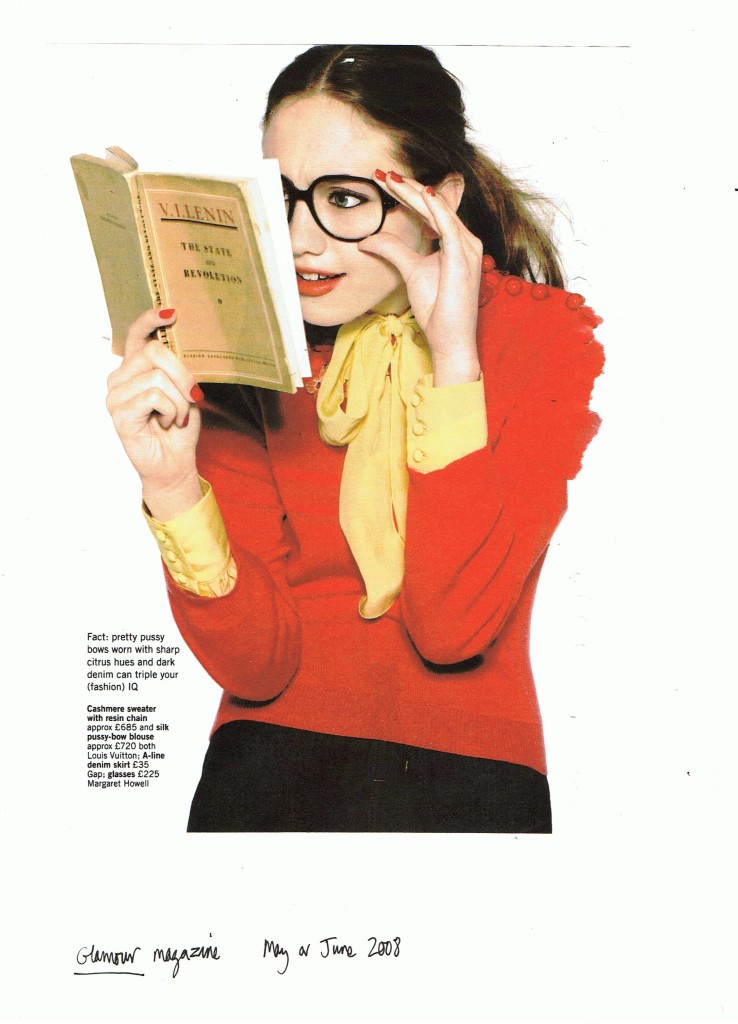Transcript
What does an image tell us about the reality it represents?
Rod Stonemanʼs latest book, Seeing is Believing: the Politics of the Visual, explores the relationship between world and image in our visually mediated society. In this series, produced and presented by Pod Academy’s Esther Gaytan-Fuertes, Rod Stoneman talks about some of the images analysed in his book.
In this first instalment of the series, he examines the language of fashion.
Rod Stoneman: This photograph is quite extraordinary in many ways. It comes from a
magazine called Glamour, Glamour Magazine and it represents a young woman in a vivid
red cardigan, I think, well I imagine itʼd be cashmere and sheʼs over intently reading a book
by V.I. Lenin called The State and Revolution. It opens a whole series of questions about
the relationship of fashion to the image system.
One can say that the world of art thatʼs included in the domain of art within the image system has been widened and the boundaries are soft and inclusive —one probably can thank Marcel Duchamp for that, the ready made and some of his other contributions began to question and open the boundaries of the domain of art. Certainly by the XXI century many museums actually combine art and architecture or craft and art and also specific exhibitions may address fashion or food or even advertising.
It somewhat integrates the domain of the commodity economy in art and to take fashion as an example of that. Fashion obviously extends back historically to all known forms of human history and society and was analysed in a more structural and rigorous way, I think, first by Roland Barthes who 1967 published a book in France called The Fashion System. He was just looking at verbal discourse and the way that it worked in the industry of fashion, but actually his approach can also work for visual representation. And there are many Fashion Studies courses in different colleges at the moment, the question is how critical they are, to what extent they perpetuate the fashion industry without deeper analysis and thought, to what extent they might begin to open up the political economy of fashion, the basic economy of fashion.
I remember a strange moment when, quite a while ago, I was walking near Postbridge in Dartmoor, in Devon (South West of England) and encountered a farmer who was shearing all his sheep on that summer afternoon. And he explained that each fleece would be paid at £1 and the sheep takes a year to grow wool. And actually,
coincidentally that thick fleece would produce enough wool for one sweater that Benetton
would be selling for about £80. There was a kind of epiphany with an extraordinary
disparity of relationship of 80 to 1 between the cost of the original raw material and the
eventual consumer price of the finished garment, after manufacture, marketing and
distribution.
So thatʼs a dimension of fashion which is crucial; another one might be or could be
called the libido of economy, the economy of the body. How fashion is part of a visual
system that affects people and unleashed eating disorders such as anorexia… you know,
thatʼs being well debated recently and Kate Moss, a model, was famous for her succinct
phrase, ʻNothing tastes as good as skinny feelsʼ. All of these factors carry fashion in to an
effect on social and economic structure and in fact, that effect is created with increased
speed as people are affected by and respond to the fashion system and buy new
garments on a increasingly speedy basis. The average purchase of garments in America
by young people in 1991 was 33 a year, by 2006 that had risen to 69. And actually we
donʼt have more living space to store or to keep so I guess the immediate obsolescence leads to clothes being discarded more frequently. And I guess itʼs time to think about that kind of economy.
……………..
Seeing is Believing: The politics of the visual is published by Black Dog (UK £19.95, US £29.95) It explores the complex and reciprocal dynamic between world and image in this most visually mediated society. Everyone ‘knows’ images can be false or deceptive, but we all live and work in constant denial of this idea and its implications. In a world saturatedwith media we act as though we are immune to their effects.Structured in six parts “History/Politics”; “Art/Culture”; “Film/Television”; “Products/Possessions”; “The Quotidian/The Strange”; “Verisimilitude/Delusion”—the book analyses clusters of images to explore differentiated themes of pictorial operation including photography, graffiti, painting, film and television. Seeing is Believing is an invitation to an intimate voyage that is permeable to the world’s upheavals, exploring the potential for contemporary forms of artistic practice to create new spaces for active participation in culture and society.
Tags: Cultural studies, Media studies, Politics of the visual, The image




Subscribe with…